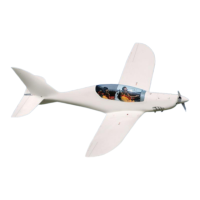4.16. HIGH SPEED FLIGHTS
Because Shark cruising speed is higher comparing to average
ultralights, there are certain risks the pilot should know about.
4.16.1. Turbulences
Shark economy cruise speed is 230 km/h. Normal cruise speed is
250 km/h and during faster flights 270 km/h. Max speed at full
continuous power is 280-300 km/h. Max speed depends on installed
systems as landing gear doors, airbox, injection, exhaust, weight,
temperature, altitude. Speed 250 km/h is possible to use for planning
long trips, it is acceptable even in turbulences.
Speed 270 km/h is comfortable for passangers when used in
conditions of lower turbulences.
Speeds over 280 km/h is comfortable only in very low turbulences.
In extremely high turbulences is good to reduce speed to 180-200
km/h.
4.16.2. Maneuvering
Maneuvering speed, when pilot can use full deflections of control
system, is 170 km/h, and airplane can reach load factor 4. Normal
cruising speed is significantly higher, so is is necessary to use smooth
movements of control system. Fast maneuvers can easily exceed
strength limits.
4.16.3. Landing gear opening
Approach and entering the traffic pattern is realized at speeds around
250 km/h. At downwind position is needed to decrease speed to 130
km/h, throttle at idle speed, and decrease speed in horizontal flight
without descending. Keep in mind it takes some time. Often mistake is
late power reducing, higher power than idle, descending. When
airplane is descending, speed doesnt decrease, and pilot can get into
the stress with next procedures. Unskilled pilots has problems with
higher speed range. They tend to fly at higher speeds, because of fear
of stall.

